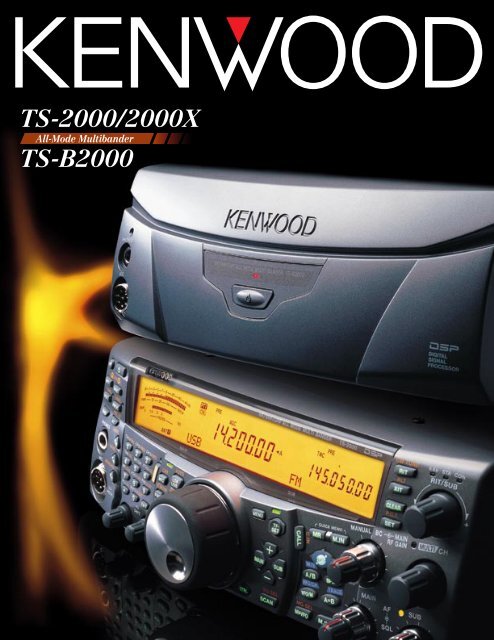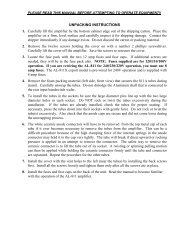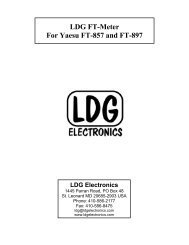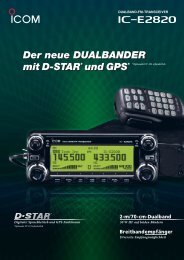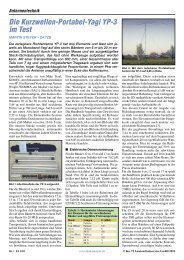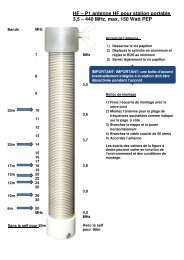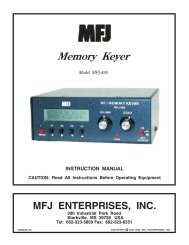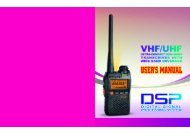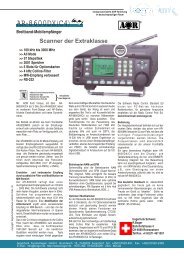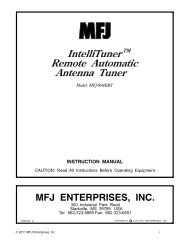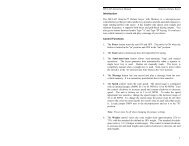You also want an ePaper? Increase the reach of your titles
YUMPU automatically turns print PDFs into web optimized ePapers that Google loves.
<strong>TS</strong>-<strong>2000</strong>/<strong>2000</strong>X<br />
All-Mode Multibander<br />
<strong>TS</strong>-B<strong>2000</strong>
Distinctive by Design, Packed for Performance<br />
All-mode multibander: HF/50/144/440/1200MHz*<br />
in one compact rig offering wide-band receive<br />
(500kHz to 1300MHz, non-contiguous) and 100W<br />
output (HF/50/144MHz) — ideal for both base<br />
station use and mobile operation.<br />
*<strong>TS</strong>-<strong>2000</strong> & <strong>TS</strong>-B<strong>2000</strong> require optional UT-20 1200MHz all-mode unit.<br />
The UT-20 can only be installed by a qualified technician; do not attempt<br />
to install it yourself.<br />
Black box version: The <strong>TS</strong>-B<strong>2000</strong> can be used<br />
exclusively for computer control or in a vehicle<br />
with a remote head*.<br />
*Optional RC-<strong>2000</strong> mobile controller<br />
Dual-channel receive: Featuring an all-mode<br />
multiband transceiver (with satellite mode) plus a<br />
sub 144/440MHz FM/AM receiver, so two frequencies<br />
(HF/50/144/440/1200*: ALL MODE + 144/440MHz:<br />
FM/AM) can be received simultaneously, even on<br />
the same band (144/440MHz).<br />
* With optional UT-20 1200MHz all-mode unit<br />
Digital signal processing: IF-DSP (main band)<br />
combines with AF-DSP (sub band) to provide precision<br />
filtering and interference reduction.<br />
Satellite communications: Main-band circuits<br />
are used for satellite mode, which thus benefits<br />
from IF-DSP.<br />
Striking design: With its large amber LCD and<br />
backlit keys, the distinctive front panel of the<br />
<strong>TS</strong>-<strong>2000</strong>/<strong>2000</strong>X improves operating ease.<br />
<strong>Kenwood</strong> Skycommand System II Plus: Built-in<br />
Transporter function means the <strong>TS</strong>-<strong>2000</strong>/<strong>2000</strong>X/<br />
B<strong>2000</strong> can be operated remotely with one handheld<br />
transceiver.<br />
High-speed processing: Superior performance is<br />
assured with two 16-bit DSP chips, double-precision<br />
computing and a 100MHz speed CPU, plus 24-bit<br />
A/D and D/A converters.<br />
High frequency stability: Built-in TCXO offers<br />
professional performance — ±0.5ppm* (-10~+50°C).<br />
*Main-band SSB, CW, FSK, AM modes only.<br />
Other features include a mobile controller and<br />
radio control software (both options), built-in auto<br />
antenna tuner, DX cluster tune, and an antenna<br />
terminal dedicated to HF low-band reception.
<strong>TS</strong>-B<strong>2000</strong> —<br />
Cutting-edge Technology<br />
in a Streamlined Package<br />
<strong>Kenwood</strong>’s new all-mode multibander<br />
breaks new ground in more ways than one.<br />
This <strong>TS</strong>-B<strong>2000</strong> black box version offers the<br />
same functionality and performance as the<br />
<strong>TS</strong>-<strong>2000</strong> — minus the controls — so you can<br />
carry it in the trunk of your car, or set up on<br />
the desk with your personal computer.
Sleek front panel with power<br />
switch and mic/headphone terminals<br />
Optional RC-<strong>2000</strong> mobile controller<br />
available for mobile use<br />
HF/50/144/440/1200*MHz<br />
All-mode Multibander<br />
* With optional UT-20 1200MHz all-mode unit<br />
Easy Mode<br />
ARCP-<strong>2000</strong> radio control software<br />
supplied for PC use
A marvel of electronic engineering: <strong>Kenwood</strong>’s<br />
stylish new all-mode multibander is packed<br />
with top-end features yet compact enough<br />
to use at home, in your car, or on a<br />
DX’pedition. With its 3D front panel,<br />
featuring backlit keys and large<br />
amber display, its appear-<br />
ance is as distinctive as<br />
its performance.<br />
HF/50/144/440/1200*MHz HF/50/144/440/1200MHz<br />
All-mode Multibander<br />
* With optional UT-20 1200MHz all-mode unit
All-Mode, Multiband, Engineered for Excellence<br />
<strong>Kenwood</strong>’s new <strong>TS</strong>-<strong>2000</strong>/<strong>2000</strong>X/B<strong>2000</strong> all-mode multibander may be<br />
compact, but it’s equipped with all the features you would expect to<br />
find in a top-of-the-line rig.<br />
IF Digital Signal Processing<br />
The <strong>TS</strong>-<strong>2000</strong>/<strong>2000</strong>X/B<strong>2000</strong> is serious about digital signal<br />
processing. <strong>Kenwood</strong>’s advanced digital technology<br />
converts analog waveforms into digital data in real-time,<br />
enabling such digital processing as IF filtering, slope<br />
tune, auto notch and AGC. IF-stage DSP on main-band<br />
transmit and receive — including V/UHF bands —<br />
allows the greatest range of control and unprecedented<br />
performance.<br />
DSP Detection<br />
IF-stage DSP means that<br />
the <strong>TS</strong>-<strong>2000</strong>/<strong>2000</strong>X/B<strong>2000</strong><br />
offers significantly lower<br />
distortion and higher<br />
quality detection in all<br />
modes. (FM: digital<br />
AF filter)<br />
Digital Filtering<br />
There is absolutely no<br />
need to purchase optional<br />
filters: digital IF filters are<br />
available for each mode<br />
(FM: digital AF filter),<br />
offering performance<br />
superior to anything<br />
possible with analog<br />
circuitry. When operating<br />
in SSB/FM/AM modes, this<br />
digital filtering enables<br />
both high- and low-cut<br />
frequency variance.<br />
Employing slope tune,<br />
you can thus cut out<br />
Interfering<br />
signal (SSB)<br />
Hi-cut<br />
slope<br />
tune<br />
SSB slope tune<br />
Lo-cut<br />
slope<br />
tune<br />
Desired<br />
signal<br />
(SSB)<br />
Interfering<br />
signal<br />
(CW)<br />
noise with minimal effect<br />
on sound quality. In AM<br />
mode, the high-cut frequency<br />
can reduce interference<br />
by controlling the<br />
IF pass bandwidth —<br />
useful for receiving shortwave<br />
broadcasts. In CW<br />
mode, the WIDTH function<br />
is supplemented by<br />
center frequency shift,<br />
allowing adjacent signal<br />
interference to be tuned<br />
out. The WIDTH function<br />
also provides noise<br />
reduction capabilities in<br />
FSK with 4 steps avail-<br />
able: 250, 500, 1000 and 1500Hz. And thanks to AF-stage<br />
DSP, independent control of high-cut and low-cut frequencies<br />
(12 steps each) provides slope tune capability in FM as well.<br />
IF Auto Notch<br />
Since it is working with a<br />
digital signal, IF Auto<br />
Notch (main band, SSB<br />
mode) can provide<br />
extremely sharp filtering<br />
of carrier frequencies<br />
from broadcast and con-<br />
Interfering<br />
signal<br />
(CW)<br />
WIDTH<br />
SHIFT<br />
DSP notch filter<br />
Beat<br />
Target<br />
signal<br />
Desired<br />
signal<br />
(CW)<br />
Interfering<br />
signal<br />
(SSB)<br />
Desired<br />
signal<br />
(CW)<br />
Interfering<br />
signal<br />
(SSB)<br />
Conventional<br />
notch filter slope<br />
tinuous beat sources. The interfering beat is removed far<br />
more accurately than in conventional analog systems, and<br />
Auto Notch will even track changes in the beat signal<br />
(tracking speed can be varied in 5 steps).<br />
IF AGC<br />
The digital AGC circuit (main band only) delivers very fast<br />
release characteristics, surpassing even the best analog<br />
designs. You can select a custom release time (20 steps) for<br />
each mode, except FM.
AF Digital Signal Processing<br />
DSP is also executed at the AF stage, offering Beat<br />
Cancel and CW Auto Tune functions. It also enables you<br />
to achieve remarkable noise reduction and apply custom<br />
enhancements to your transmitted voice.<br />
Beat Cancel<br />
Automatic Beat Cancel, available<br />
for the main band (SSB<br />
and AM modes), immediately<br />
eliminates multiple beats<br />
interfering with a desired signal.<br />
It works well in combination<br />
with IF Auto-Notch (SSB).<br />
Manual Beat Cancel<br />
A new Manual Beat Cancel<br />
function, which operates as a<br />
manual AF notch, can be used<br />
in all modes — though it is<br />
particularly effective in CW.<br />
CW Auto Tune<br />
You no longer have to adjust<br />
the VFO while operating on<br />
CW — CW Auto Tune does it<br />
for you automatically by adjusting<br />
the VFO to your preset pitch at the<br />
touch of a button.<br />
Attenuation [dB]<br />
Frequency [Hz]<br />
-500 -400 -300 -200 -100 0 -100 200 300 400 500<br />
0.0<br />
10.0<br />
20.0<br />
30.0<br />
40.0<br />
50.0<br />
60.0<br />
70.0<br />
80.0<br />
Canceled<br />
Beat Beat Beat<br />
Target signal<br />
HF Band<br />
50MHz Band 440MHz Band<br />
144MHz Band 1200MHz Band<br />
Noise Reduction<br />
There are 2 types of noise reduction: LEM (NR1) and SPAC<br />
(NR2). LEM (Line Enhancer Method) — available for all<br />
modes on the main band and FM/AM on the sub band —<br />
automatically forms a filter shape around the target signal<br />
for a custom, dynamic noise reduction capability. The<br />
degree of enhancement can also be set manually for main-<br />
band use. The SPAC (Speech<br />
Processing/Auto Correlation)<br />
function utilizes a special statistical/correlation<br />
algorithm<br />
to pull out weak signals that<br />
are buried deep in noise.<br />
Although available for all<br />
modes on the main band, it’s<br />
especially useful for tough CW<br />
conditions. The correlation<br />
time setting can be adjusted<br />
in 10 steps between 2ms and<br />
20ms.<br />
❚ Line Enhancer Method<br />
Formed filter<br />
Noise Noise<br />
❚ SPAC Method<br />
Signal<br />
Extract signal<br />
from the noise<br />
Noise Noise<br />
Signal<br />
TX Audio Shaping<br />
You have 3 ways to tailor audio quality with DSP: the<br />
TX/RX equalizer (SSB/FM/AM), TX filter bandwidth<br />
(SSB/AM), and speech processor (SSB/FM/AM). The TX/RX<br />
equalizer offers 4 frequency response settings on SSB, FM<br />
and AM: high boost for improved clarity, formant pass to<br />
minimize extraneous sounds, bass boost for stronger<br />
sound, and conventional mode for an ‘analog’ sound. On<br />
SSB and AM transmit you can choose between 6 TX filter<br />
bandwidth settings according to your microphone and<br />
operating requirements. The speech processor works<br />
across three bands (SSB, FM and AM) for high<br />
compression and minimal distortion.
Expanded Power and Performance<br />
DX Cluster (Packet Cluster) Tune<br />
DX cluster information received on the sub band is not just<br />
displayed on the LCD: it can also be used for instantly setting<br />
up the main band frequency to<br />
cluster information. Up to 10<br />
items can be stored in memory.<br />
Built-in 1200/9600bps TNC<br />
The simple 2-chip TNC is compliant with the AX.25 protocol<br />
for Sky Command and DX cluster tune.<br />
Dual-Channel Watch<br />
Provision of main and sub bands enables dual-channel<br />
watch. This all-mode multibander can simultaneously<br />
receive two frequencies, even on the same band, allowing<br />
such combinations as HF+V/UHF, VHF+VHF, UHF+UHF and<br />
VHF+UHF (the sub band is used exclusively for 144/440MHz<br />
reception on FM/AM). This<br />
means, for instance, that you<br />
can pick up local information<br />
on V/UHF while operating HF<br />
on the main band.<br />
Satellite Communications<br />
Satellite operations are enhanced with the IF-DSP, 10 dedicated<br />
memory channels, Doppler effect frequency adjustment<br />
(manual) and the ability to choose either normal or reverse<br />
shift for the trace.<br />
Up<br />
link<br />
All-mode<br />
HF/50MHz<br />
144MHz<br />
440MHz<br />
1200MHz<br />
Down link<br />
HF/50MHz 144MHz<br />
ANT terminals<br />
(HF, 50MHz)<br />
PANEL terminal for<br />
mobile controller<br />
COM (D-SUB 9-pin)<br />
terminal<br />
440MHz 1200MHz<br />
Ext. speaker<br />
terminals<br />
High-duty Transmitter Section<br />
This transceiver is the perfect 1.00<br />
choice for contesting, mobiling 0.80<br />
and FSK applications, deliver-<br />
0.60<br />
0.40<br />
ing up to 100 (AM: 25) watts<br />
0.20<br />
on HF/50/144MHz bands.<br />
0.00<br />
-0.20<br />
Output is 50 (AM: 12.5) watts -0.40<br />
on the 440MHz band, and 10<br />
-0.60<br />
-0.80<br />
(AM: 2.5) watts on 1200MHz*.<br />
But there’s more than just<br />
-1.00<br />
power: the built-in TCXO ensures<br />
excellent frequency stability — ±0.5ppm<br />
(except in FM mode).<br />
*Minimum output is 5 watts for HF/50/144/440MHz<br />
bands, 1 watt for 1200MHz.<br />
0 20 40 60 80 100 120 140 160 180<br />
Elapsed time [min]<br />
CW Features<br />
In addition to the new Auto Tune function, there is a full<br />
range of CW features. The full/semi break-in switching and<br />
delay time settings are fully adjustable. In semi break-in the<br />
delay time between key release and active receive mode<br />
can be set for between 50ms and 1000ms. When using<br />
VOX operation the delay time can be set for between<br />
150ms and 3000ms. Other CW features include pitch<br />
control (400-1000Hz), side tone monitor with 10-step<br />
volume setting, DSP-based rise time adjustment, and CW<br />
reverse mode.<br />
FSK Features<br />
When operating in FSK mode, you can select shift frequencies<br />
(170, 200, 425 and 850Hz) and switch both KEY polarity<br />
and Hi/Low tones to suit your RTTY device. Additionally,<br />
the FSK reverse function lets you match transmission methods<br />
to the other party if necessary, for example changing the<br />
BFO frequency from LSB (normal) to USB (reverse).<br />
FM Features<br />
As well as switchable Narrow/Wide deviation modes, the<br />
<strong>TS</strong>-<strong>2000</strong>/<strong>2000</strong>X/B<strong>2000</strong> has built-in CTCSS functionality<br />
with 38 EIA-standard sub-tones settings plus 1750Hz tone<br />
burst. Other features include DCS (104 codes), both crossband<br />
and fixed-band repeater operation, and 1200MHz<br />
ALT.<br />
Data Communication Features<br />
Packet filter bandwidth is fully selectable to match packet<br />
speed, and you can also switch ACC2 (PKD) input/output<br />
levels. For PSK31 mode, the menu offers a 100Hz bandwidth<br />
IF-DSP filter.<br />
Ground Ext. key terminal Paddle terminal Ext. AT terminal<br />
Ext. control<br />
terminal<br />
ACC2<br />
terminal<br />
REMOTE<br />
terminal<br />
Drift [PPM]<br />
ANT terminals<br />
(144MHz, 440MHz)<br />
DC 13.8V<br />
ANT terminal<br />
(HF RX)<br />
ANT terminal<br />
(1200MHz)<br />
Rating condition<br />
Reception setting:<br />
14.200MHz
Enhanced Operating Ease<br />
Automatic Antenna Tuner<br />
The built-in antenna tuner — which also operates when the<br />
radio is in receive mode — covers amateur bands from 1.9<br />
to 50MHz, with<br />
rapid tuning lock<br />
when using presets.<br />
300 Memory Channels<br />
This transceiver provides a bank of 300 memories (plus 1<br />
call channel for each band), with 290 assignable by name<br />
and 10 available for programmable scan. The scroll function<br />
lets you browse memory contents, memory channel<br />
copy sends the contents of one channel to another, lock-out<br />
memory changes the scan map to exclude certain channels,<br />
and memory shift alters the frequency stored in a channel.<br />
In addition, there are 10 ‘quick’ memories to capture a current<br />
operation on-the-fly — ideal for contest operation.<br />
Multiple Scan Functions<br />
A full range of scan functions is provided, including MHz<br />
scan, memory scan, and call scan. Group scan mode covers<br />
all 300 memory channels in groups of 10, and programmable<br />
band scan will search a frequency spread between two<br />
VFO settings (the scan-hold function stops the scanning for<br />
5 seconds). A new feature is programmable slow scan,<br />
which will automatically slow down to check a frequency<br />
range you’re interested in. As well as varying scan speed,<br />
you can choose either time-operated (TO) or carrier-operated<br />
(CO) busy-stop-resume.<br />
<strong>Kenwood</strong> Skycommand System II Plus<br />
The <strong>TS</strong>-<strong>2000</strong>/<strong>2000</strong>X/B<strong>2000</strong> is fully<br />
equipped for <strong>Kenwood</strong>’s Skycommand<br />
System II Plus. With just a handheld<br />
transceiver you can relax in your garden<br />
while DX’ing from your shack. Alternatively,<br />
you could enjoy HF access via<br />
the multibander in your parked car while<br />
taking in a baseball game.<br />
Conventionally two extra transceivers<br />
are required for KSS operation — a<br />
Commander and a Transporter — but the<br />
<strong>TS</strong>-<strong>2000</strong>/<strong>2000</strong>X/B<strong>2000</strong> has Transporter<br />
functions built in. This means you can<br />
operate it remotely with a single mobile<br />
or handheld unit, such as the TH-D7A or<br />
TM-D700A, transmitting control signals to<br />
the Transporter, which also relays your<br />
voice to the HF radio. In return, HF<br />
signals are transmitted back to the<br />
Commander. This system allows you to<br />
transmit and receive HF signals, set frequencies<br />
(with LCD confirmation), switch<br />
memory channels, and much more — all<br />
remotely.<br />
Other Features<br />
<strong>Kenwood</strong> Skycommand System II Plus is<br />
the most sophisticated version yet developed,<br />
enabling full-duplex operation with<br />
access to such HF functions as RIT/XIT,<br />
mode switching (USB, FM, etc.), splitfrequency<br />
operations on/off, and memory<br />
shift. Control is effected via simple TNC,<br />
Commander (CMD)<br />
TH-D7A or TM-D700A<br />
440MHz/144MHz<br />
Menu System<br />
All of the power and functions of the <strong>TS</strong>-<strong>2000</strong>/<strong>2000</strong>X/<br />
B<strong>2000</strong> can be accessed through the menu-driven display<br />
interface on the front panel. You may also activate the Quick<br />
Menu feature to access only your most commonly-used<br />
functions.<br />
Large, amber-colored backlit LCD Backlit front keys<br />
Compatible with optional DRU-3A digital recording unit<br />
Key operation announcement with optional VS-3 voice<br />
synthesizer (option)<br />
Programmable function keys<br />
Transverter (displays up to 19.99999GHz)<br />
RF gain control All-mode squelch Simple visual scan<br />
Auto simplex checker Auto repeater offset (144/1200MHz)<br />
DTMF remote control Built-in keyer<br />
Noise blanker Auto power-off<br />
440MHz band<br />
Confirmation of<br />
HF frequency<br />
HF receive audio<br />
compatible with the AX.25 protocol. In<br />
addition, if a second <strong>TS</strong>-<strong>2000</strong>/<strong>2000</strong>X/<br />
B<strong>2000</strong> unit is used as the Commander,<br />
you have control over noise reduction,<br />
noise blanker on/off and antenna<br />
switching among other functions.<br />
Voice signals<br />
Control signals<br />
440MHz band<br />
144MHz band<br />
HF Antenna<br />
<strong>TS</strong>-<strong>2000</strong>/<strong>2000</strong>X/B<strong>2000</strong><br />
with built-in Transporter (TRP)<br />
You control the <strong>TS</strong>-<strong>2000</strong>/<strong>2000</strong>X/B<strong>2000</strong> from the portable Commander (CMD).<br />
Voice is transmitted from the CMD unit on the 440MHz band.<br />
Control signals are also sent from the CMD unit on the 440MHz band.<br />
The HF signal received by the <strong>TS</strong>-<strong>2000</strong>/<strong>2000</strong>X/B<strong>2000</strong> is relayed to the CMD unit on the 144MHz band.<br />
You can confirm the HF frequency on the LCD of the CMD.
Options<br />
RC-<strong>2000</strong><br />
Mobile Controller ARCP-<strong>2000</strong><br />
Radio Control<br />
Program<br />
(Supplied with<br />
<strong>TS</strong>-B<strong>2000</strong>)<br />
MC-47<br />
Hand Microphone MC-52DM<br />
Hand Microphone<br />
with DTMF<br />
UT-20*<br />
1200MHz<br />
All-Mode Unit<br />
MC-60A<br />
Deluxe Desktop<br />
Microphone<br />
DRU-3A<br />
Digital Recording<br />
Unit<br />
MC-80<br />
Desktop<br />
Microphone<br />
VS-3<br />
Voice Synthesizer<br />
Unit<br />
MC-90<br />
DSP-compatible<br />
Desktop Microphone<br />
*The UT-20 can only be installed by a qualified technician; do not attempt to install it yourself.<br />
**Do not install the MB-430 Mobile Bracket vertically as this would adversely affect transceiver operation and safety.<br />
Specifications<br />
<strong>TS</strong>-<strong>2000</strong>/<strong>TS</strong>-<strong>2000</strong>X/<strong>TS</strong>-B<strong>2000</strong><br />
GENERAL<br />
Transmitter Frequency Range Main: 160, 80, 40, 30, 20, 17, 15, 12, 10, 6, 2 meter<br />
bands, 70, 23 (<strong>TS</strong>-<strong>2000</strong>X only) cm bands<br />
Sub: 2 meter band, 70cm band<br />
Receiver Frequency Range Main: (0.03) 0.5 ~ 30 MHz, (30) 50 ~ 54 (60) MHz,<br />
(142) 144 ~ 148 (152) , (420) 430 ~ 450 MHz,<br />
1240 ~ 1300 MHz (<strong>TS</strong>-<strong>2000</strong>X only),<br />
Sub: (118) 144 ~ 148(174) MHz,<br />
(220) 438 ~ 450 (512) MHz<br />
* Figures in parenthesis ( ) indicate VFO coverage range<br />
Mode A1A (CW), J3E (SSB), A3E (AM), F3E (FM), F1D (FSK), F2D<br />
Power Requirement 13.8 V DC ±15%<br />
Current Drain ( Less t han ) Transmit: 20.5 A ( HF, 6m, 2m ),<br />
18 A ( 70cm), 9 A (23cm)<br />
Standby: 2.6 A<br />
Operating Temperature 14° F ~ +122° F (-10° C ~ +50° C)<br />
Frequency Stability Main: Other mode within<br />
FM TX mode within<br />
Sub: Within<br />
Antenna Impedance 50Ω<br />
Microphone Impedance 600 Ω<br />
Dimensions, projections not <strong>TS</strong>-<strong>2000</strong>/X: 10-5/8 x 3-3/4 x 12-1/2 inch<br />
included (W x H x D)<br />
(270 x 96 x 317 mm)<br />
<strong>TS</strong>-B<strong>2000</strong>: 10-5/8 x 3-3/4 x 12-1/2 inch<br />
(270 x 96 x 317 mm)<br />
Weight (approx.)<br />
TRANSMITTER<br />
<strong>TS</strong>-<strong>2000</strong>: 17.19 lbs. ( 7.8 kg)<br />
<strong>TS</strong>-<strong>2000</strong>X: 18.07 lbs. (8.2 kg)<br />
<strong>TS</strong>-B<strong>2000</strong>: 16.53 lbs. ( 7.5 kg )<br />
RF Output Power<br />
Modulation<br />
SSB/CW/FM/FSK=100W, AM=25W (HF, 6m, 2m),<br />
SSB/CW/FM/FSK=50W, AM=12.5W (70cm)<br />
SSB/CW/FM/FSK=10W, AM=2.5W (23cm)<br />
SSB<br />
Balanced modulation<br />
FM<br />
Reactance modulation<br />
AM<br />
Low-level modulation<br />
Maximum Frequency Deviation Less than ±5 kHz (wide)<br />
(FM)<br />
Less than ±2.5 kHz (narrow)<br />
Spurious Radiation 1.8 ~ 28MHz: Less than –50dB<br />
50 ~ 430MHz : Less than –60dB<br />
1200MHz: Less than –50dB<br />
Carrier Suppression More than 50 dB<br />
Unwanted Sideband Suppression More than 50 dB<br />
Transmit Frequency Response (SSB) 400 ~ 2600 Hz (within -6 dB)<br />
XIT Variable Range ±20.00 kHz<br />
Antenna Tunable Range<br />
RECEIVER<br />
Circuitry<br />
16.7Ω ~ 150Ω (160 ~ 6m Band)<br />
Main: SSB/CW/AM/FSK Quadruple superheterodyne<br />
FM<br />
Triple conversion superheterodyne<br />
Sub: AM/FM<br />
Double conversion superheterodyne<br />
Intermediate Frequency<br />
Main: 1 st IF<br />
2 nd<br />
IF<br />
3 rd IF<br />
4 th<br />
IF<br />
Sub: 1 st<br />
IF<br />
2 nd ±0.5 x 10<br />
69.085 MHz or 75.925 MHz (HF ~ 50 MHz)<br />
41.895 MHz (144/440MHz), 135.495 MHz (1200MHz)<br />
10.695 MHz<br />
455 kHz<br />
12.0 kHz<br />
58.525 MHz<br />
IF<br />
455 kHz<br />
-6<br />
(±0.5 ppm)<br />
±0.5 x 10 -6 ± 2 kHz<br />
±0.5 x 10 -6<br />
± 600 Hz<br />
HS-5<br />
Deluxe<br />
Headphones<br />
(8Ω)<br />
PG-2Z<br />
DC Power<br />
Cable<br />
RECEIVER (Continued)<br />
Sensitivity<br />
Main: SSB/CW/FSK<br />
(S/N 10 dB)<br />
AM (S/N 10 dB)<br />
FM (12 dB SINAD)<br />
Sub: AM (S/N 10 dB)<br />
FM (12 dB SINAD)<br />
Squelch Sensitivity<br />
Main: SSB/CW/AM/FSK<br />
FM<br />
Sub: AM<br />
FM<br />
HS-6<br />
Small<br />
Headphones<br />
(12.5Ω)<br />
MB-430**<br />
Mobile Bracket<br />
PS-53 SP-23<br />
Heavy-duty Power External<br />
Supply<br />
Speaker<br />
MC-43S<br />
Hand Microphone<br />
SP-50B<br />
Mobile Speaker<br />
Not all accessories may be available, please contact dealers for details.<br />
<strong>TS</strong>-<strong>2000</strong>/<strong>TS</strong>-<strong>2000</strong>X/<strong>TS</strong>-B<strong>2000</strong><br />
Less than 4 µV (500 kHz ~ 1.705 MHz),<br />
Less than 0.2 µV (1.705 ~ 24.5 MHz),<br />
Less than 0.13 µV (24.5 ~ 30 MHz),<br />
Less than 0.13 µV (50 ~ 54 MHz),<br />
Less than 0.16 µV (144 ~ 148 MHz),<br />
Less than 0.11 µV (430 ~ 450 MHz),<br />
Less than 0.11 µV (1240 ~ 1300MHz),<br />
Less than 31.6 µV (500 kHz ~ 1.705 MHz),<br />
Less than 2 µV (1.705 ~ 24.5 MHz),<br />
Less than 1.3 µV (24.5 ~ 30 MHz),<br />
Less than 1.3 µV (50 ~ 54 MHz),<br />
Less than 1.4 µV (144 ~ 148 MHz),<br />
Less than 1.0 µV (430 ~ 450 MHz),<br />
Less than 1.0 µV (1240 ~ 1300MHz)<br />
Less than 0.22 µV (28 ~ 30 MHz),<br />
Less than 0.22 µV (50 ~ 54 MHz),<br />
Less than 0.25 µV (144 ~ 148 MHz),<br />
Less than 0.18 µV ( 430 ~ 450 MHz),<br />
Less than 0.18 µV (1240 ~ 1300MHz)<br />
Less than 2. 25 µV (144 ~ 148 MHz),<br />
Less than 1. 55 µV (438 ~ 450 MHz)<br />
Less than 0. 40 µV (144 ~ 148 MHz),<br />
Less than 0. 28 µV (438 ~ 450 MHz)<br />
Less than 18 µV (500 kHz ~ 1.705 MHz),<br />
Less than 1. 8 µV (1. 8 ~ 28.7 MHz),<br />
Less than 1. 1 µV (50 ~ 54 MHz),<br />
Less than 1. 1 µV (144 ~ 148 MHz),<br />
Less than 1. 1 µV (44 0 ~ 450 MHz),<br />
Less than 1.1 µV (1240 ~ 1300MHz)<br />
Less than 0.2 µV (28 ~ 30 MHz),<br />
Less than 0.2 µV (50 ~ 54 MHz),<br />
Less than 0.16 µV (144 ~ 148 MHz),<br />
Less than 0.1 µV (430 ~ 450 MHz),<br />
Less than 0.1 µV ( 1240 ~ 1300MHz)<br />
Less than 1. 1 µV (144 ~ 148 MHz),<br />
Less than 1.1 µV (438 ~ 450 MHz)<br />
Less than 0.23 µV ( 144 ~ 148 MHz),<br />
Less than 0.18 µV (438 ~ 450 MHz)<br />
Image Rejection Ratio<br />
Main / Sub More than 70 dB / More than 60 dB<br />
IF Rejection Ratio<br />
Main / Sub More than 70 dB / More than 60 dB<br />
Selectivity<br />
Main: SSB (Low: 300 Hz,<br />
Hi: 2600 Hz)<br />
AM (Low:100 Hz,<br />
Hi:3000 Hz)<br />
FM<br />
Sub: AM<br />
FM (Narrow)<br />
FM<br />
More than 2.2 kHz (-6 dB),<br />
Less than 4.4 kHz (-60 dB)<br />
More than 6.0 kHz (-6 dB),<br />
Less than 12.0 kHz (-50 dB)<br />
More than 12.0 kHz (-6 dB),<br />
Less than 25.0 kHz (-50 dB)<br />
More than 8 .0 kHz (-6 dB),<br />
Less than 20 .0 kHz (-50 dB)<br />
More than 12.0 kHz (-6 dB),<br />
Less than 25.0 kHz (-50 dB)<br />
More than 12.0 kHz (-6 dB),<br />
Less than 25.0 kHz (-50 dB)<br />
RIT Variable Range ±20.00 kHz<br />
Notch Filter Reduction More than 30 dB (1 kHz)<br />
Beat Elimination More than 40 dB (1 kHz)<br />
Low Frequency Output More than 1.5 W 8 Ω at 10% distortion<br />
<strong>Kenwood</strong> follows a policy of continuous advancement in development.<br />
For this reason specifications may be changed without notice.<br />
These specifications are guaranteed for Amateur Bands only.<br />
CA222KP-E-10(00) 001108.3B Printed in Japan


